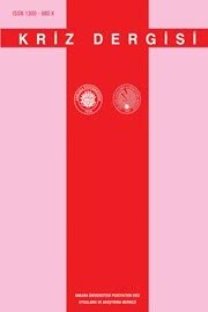Eğitim Çalışanlarında Uyku Kalitesi ve Tükenmişlik SENDROMU
Anahtar Kelimeler:
Uyku kalitesi, tükenmişlik sendromu, eğitim çalışanları
Sleep Quality and Burnout Syndrome Among Teaching Staff
Objective: The studies that address riskfactors of burnout syndrome make more emphasize on sleep quality as well as occupationalcharacteristics. The aim was to assess influenceof sleep quality on occupants’ burnout syndrome as occupational and demographical characteristics were taken into account. Method:Demographical questionnaire, Maslach BurnoutInventory and Pittsburgh Sleep Quality Indexwere administered among 198 teachers workingin Van Centrum. Relations between occupational and demographical characteristics, sleepquality, and burnout syndrome were analyzedusing regression trees. Results: Subjectivesleep quality was substantially associated toEmotional Exhaustion and Depersonalization inwhich both represent stress related dimensionsof burnout syndrome. Personal Accomplishmentwas predicted by occupational characteristics.Conclusion: Sleep quality plays an importantrole on elevations of burnout scores. Interventions in order to improve occupants’ sleep quality will contribute to their work quality and prevent their psychological health
Keywords:
Sleep quality, burn out syndrome, teaching staff,
___
- Agargün M Y, Kara H, Anlar O (1996) Pittsburgh Uyku Kalitesi İndeksinin Geçerliği ve Güvenirliği. Türk Psikiyatri Dergisi, 7: 107-115.
- Åkerstedt T, Knutsson A, Westerholm P ve ark (2002) Sleep Disturbances, Work Stress and Work Hours: A Cross-Sectional Study. J Psychosom Res, 53 (3): 741-748.
- Åkerstedt T, Knutsson A, Westerholm P ve ark (2004) Mental Fatigue, Work and Sleep. J Psychosom Res, 57 (5): 427-433.
- Åkerstedt T, Landström U (1998) Work Place Countermeasures of Night Shift Fatigue. Int J Ind Ergonomics, 21 (3-4): 167-178.
- Arslan H, Ünal M, Aslan O ve ark (1996) Pratisyen Hekimlerde Tükenme Düzeyleri. Düşünen Adam, 9 (3): 48-52.
- Bosma H, Peter R, Siegrist R ve ark (1998) Two Alternative Job Stress Models and the Risk of Coronary Heart Disease. Am J Public Health, 88(1): 68–74.
- Buysee DJ, Reynolds CF, Monk TH ve ark (1989) The Pittsburgh Sleep Quality Index: A New Instrument for Psychiatric Practice and Research. Psychiatry Res 28: 193-213.
- Buysse DJ, Reynold CF, Monk TH ve ark (1991) Quantification of Subjective Sleep Quality in Healthy Elderly Men and Women Using the Pittsburgh Sleep Quality Index (PSQI). Sleep, 14: 331-338
- Bültmann U, Kant IJ, van den Brandt PA ve ark (2002) Psychosocial Work Characteristics As Risk Factors for the Onset of Fatigue and Psychological Distress: Prospective Results from the Maastrich Cohort Study. Psychol Med, 32: 333–345.
- Cropley M, Dijk D, Stanley N (2006) Job Strain, Work Rumination, and Sleep in School Teachers Eur J Work Organ Psychol, 15 (2): 181–196.
- Cordes CL, & Dougherty TW (1993) A Review and Integration of Research on Job Burnout. Academy of Management Review, 18, 621-656.
- Çam O (1992) Tükenmişlik Envanteri'nin Geçerlik ve Güvenirliğinin Araştırılması. VII. Ulusal Psikoloji Kongresi Bilimsel Çalışmaları, sayfa 155- 160, Türk Psikologlar Derneği Yayınları, Ankara.
- Dalakas MC, Mock V, Hawkins MJ (1998) Fatigue: Definitions, Mechanisms, and Paradigms for Study. Semin Oncol, 25: 48–53.
- Demerouti E, Bakker AB, Nachreiner F ve ark (2001) The Job Demands–Resources Model of Burnout. J Appl Psychol, 86: 499–512.
- Demiral Y, Soysal A, Bilgin CA ve ark (2006) The Association of Job Strain with Coronary Heart Disease and Metabolic Syndrome in Municipal Workers in Turkey. J Occup Health, 48(5):332-338.
- Dolunay AB, Piyal B (2003) Öğretmenlerde Bazı Mesleki Özellikler ve Tükenmişlik. Kriz Dergisi, 11(1): 35-48.
- Ergin C (1992) Doktor ve Hemşirelerde Tükenmişlik ve Maslach Tükenmişlik Ölçeği'nin Uyarlanması. VII. Ulusal Psikoloji Kongresi Bilimsel Çalışmaları, sayfa 143-154, Türk Psikologlar Demeği Yayınları, Ankara.
- Haran S, Özgüven HD, Ölmez Ş ve ark (1998) Ankara Üniversitesi Tıp Fakültesi Hastaneleri ve Ankara Numune Hastanesinde Çalışan Doktor ve Hemşirelerde Tükenmişlik Düzeyleri. Kriz Dergisi, 6(1): 75-84.
- Hardy GE, Shapiro DA, Borrill CS (1997) Fatigue in the Workforce of National Health Service Trusts: Levels of Symptomatology and Links with Minor Psychiatric Disorder, Demographic, Occupational and Work Role Factors. J Psychosom Res, 43, 83–92.
- Kalimo R, Tenkanen L, Härmä M ve ark (2000) Job Stress and Sleep Disorders: Findings from the Helsinki Heart Study. Stress Med, 16(2): 65 – 75.
- Karasek RA, Theorell T (1990) Healthy Work: Stress, Productivity, and the Reconstruction of Working Life. New York: Basic Books.
- Landsbergis PA (1988) Occupational Stress Among Health Care Workers: A Test of the Job Demands Control Model. J Organ Behav, 9: 217-239.
- Lewis G, Wessely S (1992) The Epidemiology of Fatigue: More Questions Than Answers. J Epidemiol Comm Health, 46: 92–97
- Maslach C (2003) Job Burnout: New Directions in Research and Intervention. Curr Dir Psychol Sci,12 (5), 189–192.
- Maslach C, Jackson SE (1986) Maslach Burnout Inventory Manual 2 Baskı, Consulting Psychologist Press Palo Alto CA
- Maslach C, Schaufeli WB, Leiter MP (2001) Job Burnout. Annu Rev Psychol, 52:397–422.
- Nasermoaddeli A, Sekine M, Hamanishi S ve ark (2002) Job Strain and Sleep Quality in Japanese Civil Servants with Special Reference to Sense of Coherence. J Occup Health, 44(5): 337-342.
- Shen J, Botly LCP, Chung SA ve ark (2006) Fatigue and Shift Work. J Sleep Res, 15 (1): 1-5.
- Sucuoğlu B, Kuloğlu N (1996) Özürlü Çocuklarla Çalışan Öğretmenlerde Tükenmişliğin Değerlendiril- mesi. Türk Psikoloji Dergisi, 11 (36):44-60.
- Theorell T, Perski A, Åkerstedt T ve ark (1988) Changes in Job Strain in Relation to Changes in Physiological State. Scand J Work Environ Health, 14: 189–196.
- Watt T, Gronenvold M, Bjorner JB ve ark (2000) Fatigue in the Danish General Population. Influence of Sociodemographic Factors and Disease. J Epidemiol Comm Health, 54: 827–833.
- ISSN: 1300-980X
- Başlangıç: 1992
- Yayıncı: Ankara Üniversitesi
Sayıdaki Diğer Makaleler
Sinema Filmlerinde İntihar: Araştırma, Eğitim ve Sinematerapi
SİNEMA FİLMLERİNDE İNTİHAR: ARAŞTIRMA, EĞİTİM VE SİNEMATERAPİ
P. ÖNER, Ö.ş. ÜNERİ, B. REZAKİ, Ş. BODUR
Alzheimer Hastalarının Yakınlarında Bakımevi Tercihini Belirleyen Faktörler
